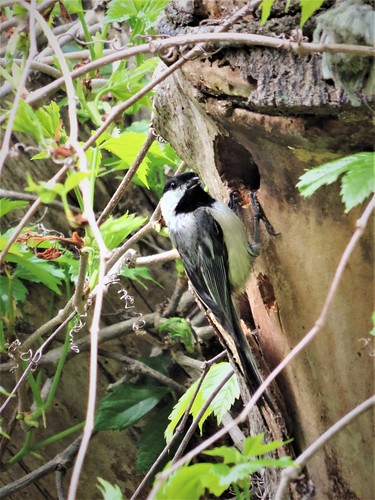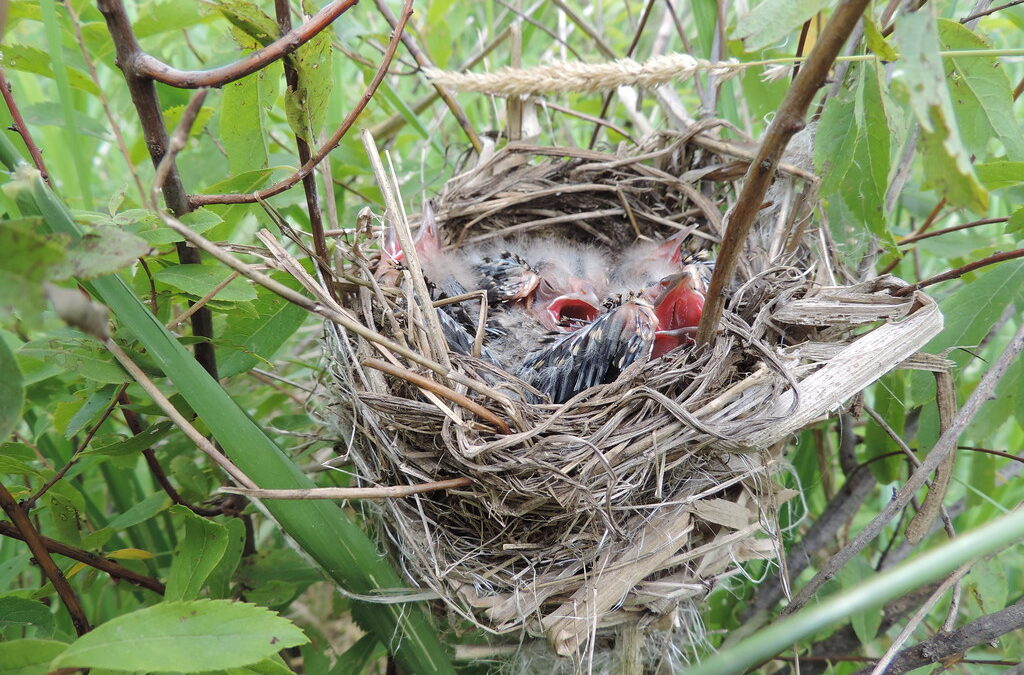By Charlotte Schmaltz, Nature Educator
Spring is finally here, and with it comes new life and growth. All sorts of animals are getting ready to raise their young, and birds are no exception. If you take a step outside you are likely to hear birds as they sing to claim territory and find a place to make their nests.

Birds build nests as a place to incubate their eggs and raise their chicks until they are old enough to fledge. Birds only raise their young in nests, but they don’t live in them year-round, a common misconception. To make the inside comfortable for their young, birds will line their nest with down feathers (the same ones that may fill your own pillow) as well as soft grass and mosses. The world of nests is diverse, and each bird species builds them differently. Some birds just find an existing space and make it theirs, while others are truly engineers, creating elaborate structures with nothing but a beak and two little feet. There are even bird species, like the Great Horned Owl, that only use the old and abandoned nests of other species. However, nests can be divided into a few major categories based on how they look and are constructed, and even where they are built.
What you probably imagine when you think of a bird nest is the cup nest. This is the most common type of nest and is used by many different birds like robins, hummingbirds, and eagles. The scale of a cup nest can vary greatly, from a delicate hummingbird nest made with spider silk and moss, to the gigantic nest of the Bald Eagle, with branches that can easily reach 4 – 6 feet long. And although many birds build cup nests in trees or bushes, there are some species like the Canada Goose which will build them on the ground. Despite the incredible size differences that exist, the basic structure of a cup nest remains the same. Birds commonly use sticks and twigs to make cup nests, weaving in grasses and other long things like stems and even manmade objects like string and twine.

Another popular type of nest used by birds is the cavity nest. Instead of building a nest from scratch, cavity nesters will find or carve a hole in something like a dead tree to make a suitable nest for their young. The cavity made by a bird one year may become the nest used by a new species the next year. This type of nest is used by owls, Wood Ducks, woodpeckers, bluebirds, and more. These nesters are also the ones most likely to make use of a birdhouse if you put one up, because a birdhouse is essentially a manmade cavity. They come in many sizes to accommodate different species. An Eastern Bluebird house is going to be much smaller than a birdhouse made for a Wood Duck or large owl. Nest boxes are helpful for cavity nesters, especially because they have a difficult time finding nesting spots when snags (dead trees) are cut down. This is a good reason to leave snags standing because they help so many species.
Scrape nests are the least impressive when it comes to construction, being little more than a small indent in the ground. These bird species rely more on egg camouflage than the nest to protect their young. Killdeer are a good example of a bird that uses this type of nest. If a parent sees a potential predator, such as a fox, getting too close then they will pretend to be injured somewhere else nearby, luring the predator away with the thought of an easy meal. Once the threat has left the eggs, the bird will take flight, disappointing the predator while keeping their eggs safe and hidden.
Cliff nests are self-explanatory, built on the side/outcrop of a cliff, instead of in a tree or on the ground. These birds use sheer vertical walls as protection from nest predation. Cliff Swallows make their nests out of mud and can be found in colonies on the side of cliffs. Peregrine Falcons are cliff nesters, and you may have heard of them nesting on skyscrapers for this reason. Pigeons also use this type of nest, but the main goal of their nest is to make sure the eggs don’t roll away or fall. That’s why their nest construction looks kind of pathetic when compared to, say, a robin’s beautiful cup nest.
Orioles make a completely unique type of nest that is woven and looks like a hammock. Hammock nests are one of the more complex types of bird nests, made of dried grasses woven together to make a sort of pouch. Their nests hang from a tree and have a built-in entrance. It’s both amazing and fascinating how they can create such a sturdy structure like this, and a great example of complex bird engineering.

While many birds claim an individual nesting territory and defend it fiercely from intruders, there a few species who nest in groups. For example, Great Blue Herons, nest in groups called rookeries. Herons might have multiple nests in one huge tree
I can’t wait until eggs hatch, and we see fledglings around. I love how awkward they are as they learn how to move around and fly. Once all the young have grown up and left the nest, it is abandoned until the next year. Some birds will use the same nest year after year, but others make a whole new nest every breeding season.
Now is the perfect time to search for bird nests before all the trees and bushes leaf out again and make them impossible to find. Look out for birds carrying sticks or bits of fluff in their beak, as they are likely bringing them back to a nesting site. Although it is amazing to watch birds grow in a nest, it is also very important that the parents are minimally disturbed, as this increases the chance of young successfully fledging and the chances that they will return in the future. Spring is a beautiful time of year, and in my mind the start of the nesting season only serves to emphasize it.
Audubon Community Nature Center builds and nurtures connections between people and nature. ACNC is located just east of Route 62 between Warren and Jamestown. The trails are open from dawn to dusk and birds of prey can be viewed anytime the trails are open. The Nature Center is open from 10 a.m. until 4:30 p.m. daily except Sunday when it opens at 1 p.m. More information can be found online at auduboncnc.org or by calling (716) 569-2345.
Feature image: Baby birds in a cup nest


Recent Comments